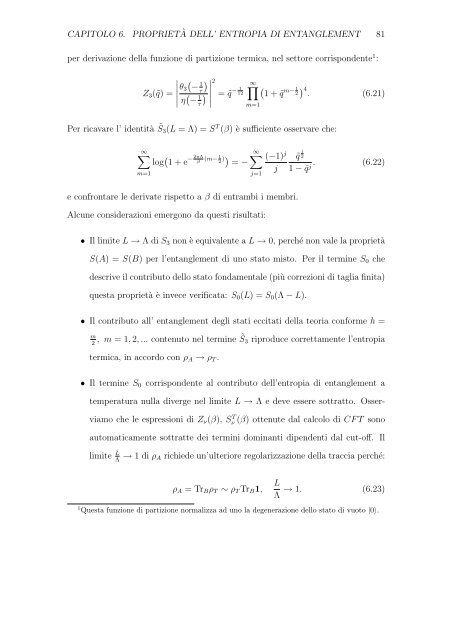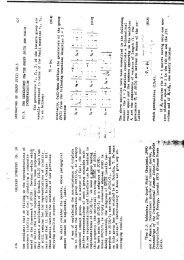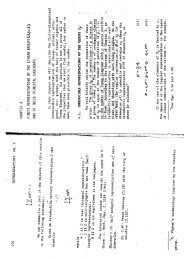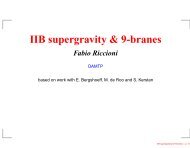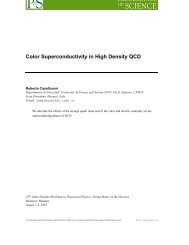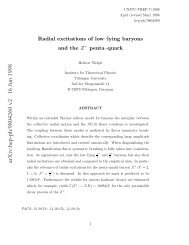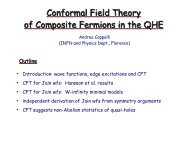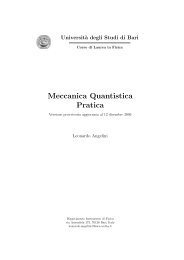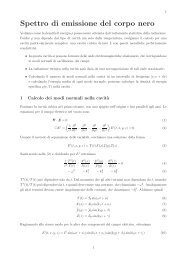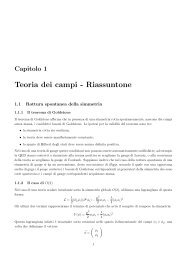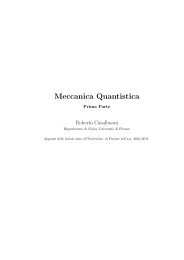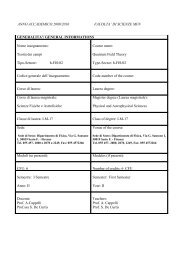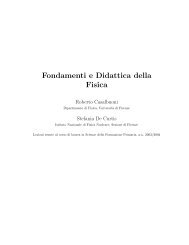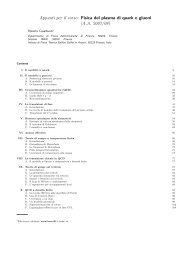entropia di entanglement in teorie invarianti conformi bidimensionali
entropia di entanglement in teorie invarianti conformi bidimensionali
entropia di entanglement in teorie invarianti conformi bidimensionali
Create successful ePaper yourself
Turn your PDF publications into a flip-book with our unique Google optimized e-Paper software.
CAPITOLO 6. PROPRIETÀ DELL’ ENTROPIA DI ENTANGLEMENT 81<br />
per derivazione della funzione <strong>di</strong> partizione termica, nel settore corrispondente 1 :<br />
<br />
<br />
1<br />
θ3<br />
− τ<br />
Z3(˜q) = <br />
η − 1<br />
<br />
<br />
<br />
<br />
<br />
<br />
τ<br />
2<br />
1<br />
−<br />
= ˜q 12<br />
∞<br />
m=1<br />
m−<br />
1 + ˜q 1 4. 2<br />
(6.21)<br />
Per ricavare l’ identità ˜ S3(L = Λ) = S T (β) è sufficiente osservare che:<br />
∞<br />
log 1 + e<br />
m=1<br />
2πΛ 1<br />
− (m− β 2 ) = −<br />
∞ (−1) j<br />
e confrontare le derivate rispetto a β <strong>di</strong> entrambi i membri.<br />
j=1<br />
Alcune considerazioni emergono da questi risultati:<br />
j<br />
˜q j<br />
2<br />
. (6.22)<br />
1 − ˜q j<br />
• Il limite L → Λ <strong>di</strong> S3 non è equivalente a L → 0, perché non vale la proprietà<br />
S(A) = S(B) per l’<strong>entanglement</strong> <strong>di</strong> uno stato misto. Per il term<strong>in</strong>e S0 che<br />
descrive il contributo dello stato fondamentale (più correzioni <strong>di</strong> taglia f<strong>in</strong>ita)<br />
questa proprietà è <strong>in</strong>vece verificata: S0(L) = S0(Λ − L).<br />
• Il contributo all’ <strong>entanglement</strong> degli stati eccitati della teoria conforme h =<br />
m<br />
2 , m = 1, 2, ... contenuto nel term<strong>in</strong>e ˜ S3 riproduce correttamente l’<strong>entropia</strong><br />
termica, <strong>in</strong> accordo con ρA → ρT .<br />
• Il term<strong>in</strong>e S0 corrispondente al contributo dell’<strong>entropia</strong> <strong>di</strong> <strong>entanglement</strong> a<br />
temperatura nulla <strong>di</strong>verge nel limite L → Λ e deve essere sottratto. Osser-<br />
viamo che le espressioni <strong>di</strong> Zν(β), S T ν (β) ottenute dal calcolo <strong>di</strong> CF T sono<br />
automaticamente sottratte dei term<strong>in</strong>i dom<strong>in</strong>anti <strong>di</strong>pendenti dal cut-off. Il<br />
limite L<br />
Λ → 1 <strong>di</strong> ρA richiede un’ulteriore regolarizzazione della traccia perché:<br />
ρA = TrBρT ∼ ρT TrB1, L<br />
Λ<br />
→ 1. (6.23)<br />
1 Questa funzione <strong>di</strong> partizione normalizza ad uno la degenerazione dello stato <strong>di</strong> vuoto |0〉.


